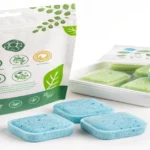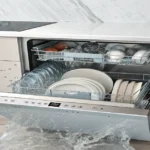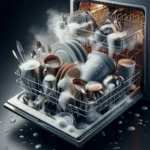Who wants to be greeted with cloudy glasses and speckled plates when you open your dishwasher? You know I get it, it sucks!
Through years (and some costly repairs) I learned the hard way that too much dishwasher salt was not only unnecessary but damaging.
So in this guide, I’ll share everything I’ve learned about how to keep your dishwasher going strong and your dishes shining bright.
What’s the Deal with Dishwasher Salt Anyway?
Why does your dishwasher require its specific kind of salt?
Trust me, that same question crossed my mind when I first started using my Bosch dishwasher!
You will help the limescale in the dishwasher with softener salt. Salt is not created for tastiness but ironically, to make the food taste worse.
I then realized that I lived in a hard water area, so those white marks weren’t disappearing off my glasses without the appropriate level of salt.
The salt is used to aid the dishwasher’s internal softener in washing out calcium and magnesium from the water.
How Do I Know When It’s Time to Add More Salt?
Think how great it would be if our dishwashers could talk to us. Why not?
It sorta does! Most modern dishwashers have an indicator light that shows when the salt level gets low.
But this is what I see in my kitchen:
- In soft water areas: You might only need to add salt every few months
- With medium water hardness: Monthly top-ups usually do the trick
- In hard water areas: You’ll probably be refilling every 2-3 weeks
“Think of dishwasher salt like oil in your car – you might not see it working, but you’ll definitely notice when it’s missing!” – My local appliance repair guy
The Big No-No: Can I Just Use Regular Table Salt?
I get this question all the time, and I’ll be straight with you – please don’t! While it might seem like a money-saving hack, using table salt is like putting the wrong fuel in your car.
Here’s why:
- Table salt contains additives that can clog up your machine
- The granules are the wrong size and don’t dissolve properly
- It could end up costing you hundreds in repairs
My Fool-Proof Method for Adding Salt (Without Making a Mess!)
After countless spills, I’ve finally mastered the art of adding salt without turning my kitchen floor into a winter wonderland. Here’s my step-by-step process:
- Find the salt reservoir (usually at the bottom of your dishwasher)
- Grab a funnel (trust me, this is a game-changer!)
- Unscrew the cap slowly
- Fill with water first if it’s empty
- Pour in the salt until you can’t add any more
- Wipe up any spills and replace the cap
Pro tip: I always run an empty cycle after adding salt, just to be safe!
Help! How Do I Know If My Dishwasher is Salt-Starved?
Your dishwasher has several ways of crying out for salt. In my experience, these are the tell-tale signs:
- A persistent salt warning light
- Dishes that feel slightly gritty
- White residue on dark-colored dishes
- Water spots on glasses
- The machine just isn’t cleaning as well as it used to
| Water Type | Salt Usage | Warning Signs |
|---|---|---|
| Soft | Low | Occasional spots |
| Medium | Moderate | Monthly indicator |
| Hard | High | Frequent alerts |
What Happens If You Forget to Add Salt?
Let me share a painful lesson I learned the hard way. Skipping salt can lead to:
- Limescale build-up inside your machine
- Higher energy bills (limescale makes your machine work harder)
- Poor cleaning results
- Potential damage to heating elements
Can You Go Overboard with Salt?
Yes, you absolutely can! I once dumped in way too much salt, thinking “More is better.” Spoiler alert: it’s not. Too much salt can:
- Create a salty residue on your dishes
- Cause the softener unit to malfunction
- Lead to over-softened water (yes, that’s a thing!)

Quick Fixes for Common Salt Problems
After years of using my dishwasher, here are some tricks I’ve learned:
- Salt light won’t go off? Try running an empty cycle
- Dishes still spotty? Check your water hardness settings
- Is salt not dissolving? Make sure there’s water in the reservoir
Testing Your Water Hardness: A Home Guide
Understanding your water hardness doesn’t require a chemistry degree. Here’s what works for me:
- Get some test strips from your local hardware store
- Dip one in a glass of tap water
- Compare the color to the chart
- Adjust your salt usage accordingly
Maintaining Optimal Softness
The water softening system needs regular topping to ensure dishes come out clean and sparkling. Your user manual specifies how often you should use salt based on your local water hardness.
Whether you own a Siemens or another brand, proper salt maintenance is crucial for super service from your appliance.
Maintaining Optimal Softness
The water softening system needs regular topping to ensure dishes come out clean and sparkling. Your user manual specifies how often you should use salt based on your local water hardness.
Whether you own a Siemens or another brand, proper salt maintenance is crucial for super service from your appliance.
FAQs From My Kitchen to Yours
Q: How much does dishwasher salt cost?
A: I usually pay around $5-10 for a big bag that lasts months.
Q: Can I run my dishwasher without salt if I use tablets with built-in softener?
A: From experience, you still need salt in hard water areas.
Q: How often should I check the salt level?
A: I peek at mine monthly, just to be safe.
Key Takeaways:
- Always use proper dishwasher salt
- Check levels monthly
- Fill when adding salt
- Run an empty cycle after refilling
- Keep an eye on warning lights
- Regular maintenance prevents bigger problems
Conclusion
Remember: A little attention to your dishwasher’s salt needs now can save you from bigger headaches later!
This guide comes from years of personal experience with my dishwasher. While different models might have slightly different needs, these basics should help keep your dishes sparkling and your machine running smoothly for years to come

I’m Ian Welkins, a seasoned professional in the kitchen industry. My passion now drives me to provide invaluable insights into the world of top-notch kitchen products. With years of hands-on experience, I’m your go-to source for culinary excellence.











